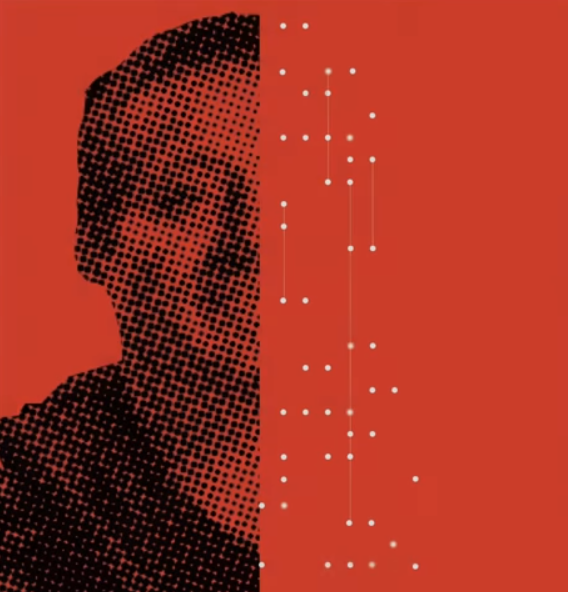Can you imagine ever sharing with your customers what the actual costs of your product are?…
Or sharing actual financials with your team?…
Or giving competitors your secret “sauce” to save on production costs?
It sounds a little wild, but it’s truly something to consider as another competitive advantage that Evolved Enterprises enjoy.
“Trust Is The New Currency”…
That’s the insight Kimbal Musk, shared during his keynote presentation at the recent Underground® seminar.
We’re living in a time when the public trust for governments, corporations and other institutions is at a significant low point. How do we garner trust from our team members, customers and other stakeholders?
It’s easy, but not necessarily simple.
Trust comes from transparency. And that’s happening whether we like it or not.
Kimbal practices trust within his group of The Kitchen restaurants: first by providing information to patrons about the source of their food on their table and second by their commitment to helping support local farmers and service providers around each restaurant.
The old model for business was based on access to information or markets that others didn’t have. This arbitrage created a competitive advantage. However, with our interconnected world and always-on devices, the game has changed significantly. I think anything “secret” will eventually come out. Considering uncensored sites exposing institutional secrets like Wiki Leaks, I’d say it’s happening sooner rather than later.
I remember having drinks a little while back with Tony Hsieh, CEO of Zappos.com, in downtown Vegas. This was right at the time when Twitter was starting to gain momentum and he had reached over 1M followers. I asked him, “Do you care if someone snaps a photo of you doing something inappropriate and posts it online?”
His reply was simple and perfect, “I live my life considering my grandmother will see whatever I do on the front page of the paper tomorrow.”
That kind of attitude makes everything easier. Instead of hiding, he’s embracing the scrutiny.
Radical Transparency
One Evolved Enterprise really thriving with their transparency practice is online clothing e-tailer, Everlane. They are committed to showing the consumer what an item costs, reducing the middleman fees and even shedding light on opaque factory conditions where apparel is made.
This screenshot explains the ethos behind their philosophy:
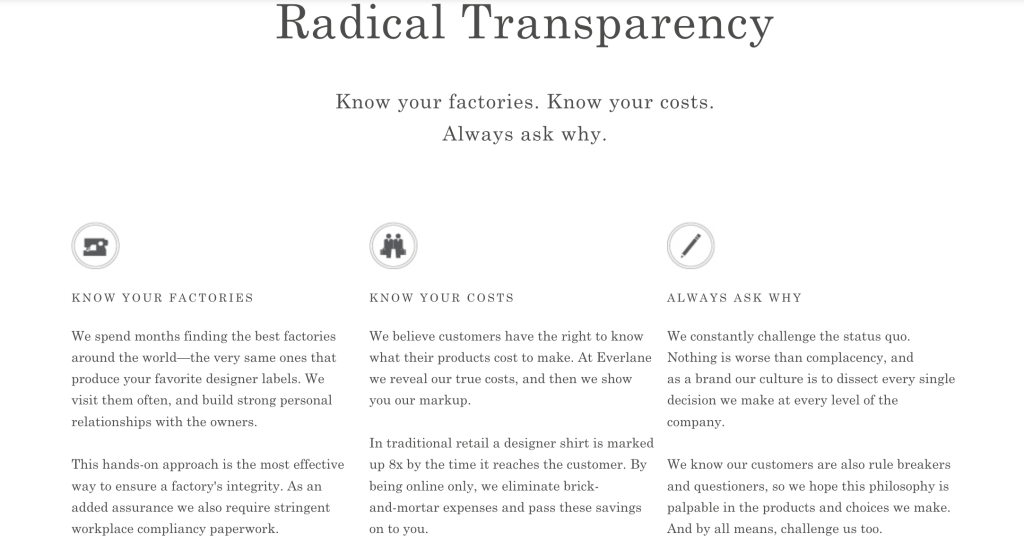
Here is an example of transparent pricing for a t-shirt they sell for $22. Notice the specific costs for each of the components. The hard cost is $9 plus a $5 donation to the ACLU for this shirt line.
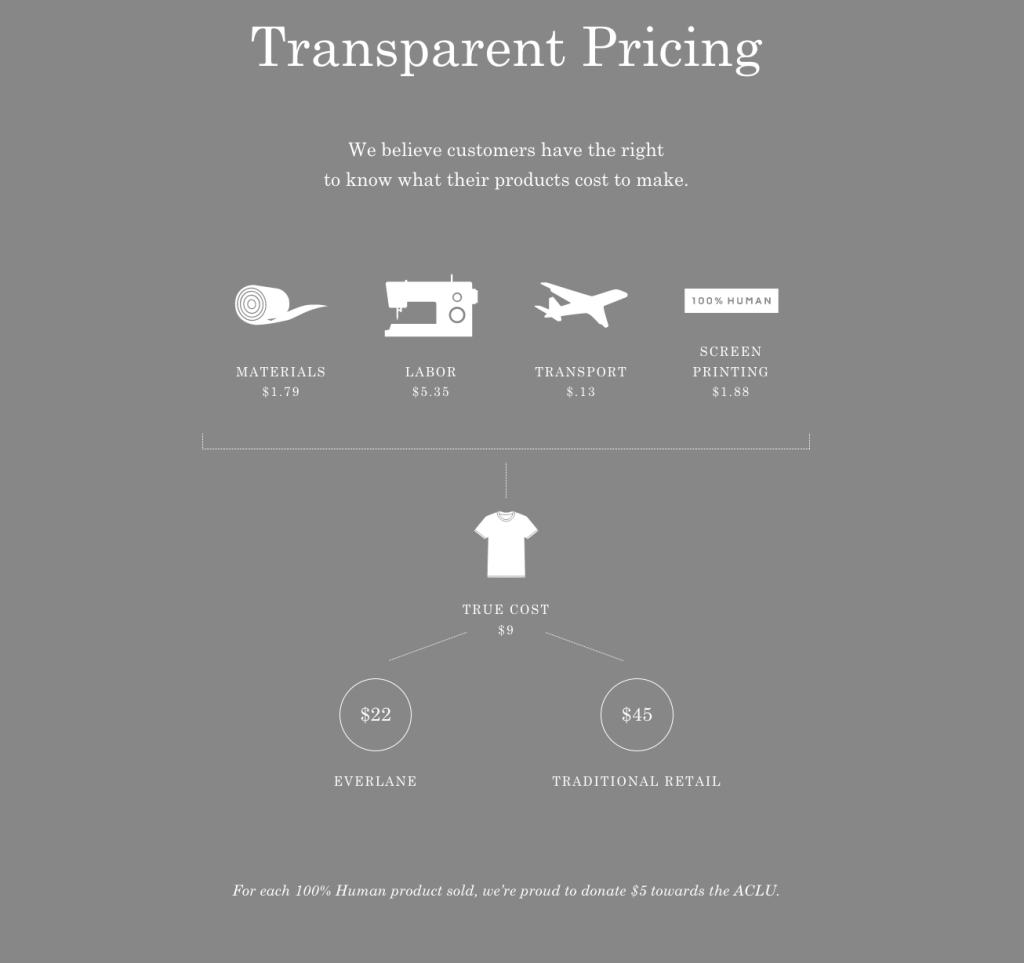
Everlane goes one step further with transparency to their manufacturing process. On their site you can also dig deeper into the story behind each factory that a piece of clothing is made in. By sharing this information you feel even more connected to the product you are wearing or buying, building the COMMUNITY aspect of the Evolved Enterprise framework.
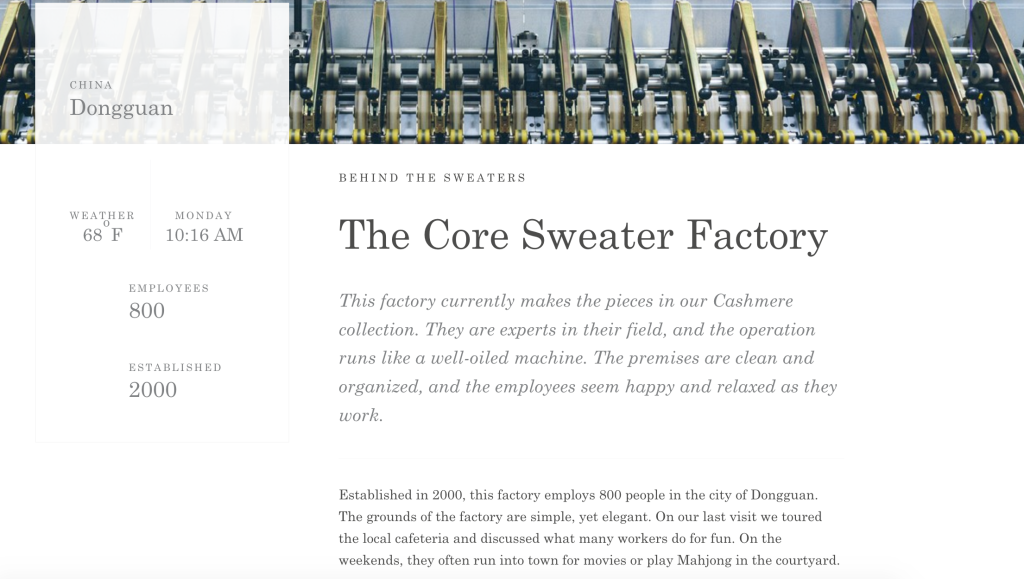
Pay What You Want
Another example of this radical transparency is their marketing strategy of what to do with overstocked merchandise. They’ve provided an excellent reason-why with the explanation that they sometimes overproduce items from designs they love and don’t predict demand right.
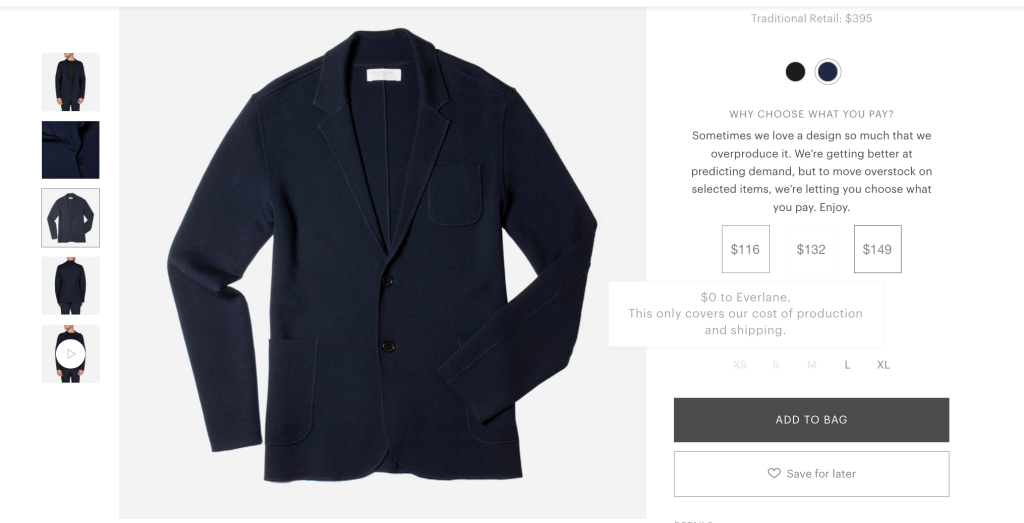
The retail price is $395 for this jacket and they provide you with three “choose-your-own-prices”. If you mouse-hover over the prices you’ll see how much margin is in there for Everlane. In this example, I clicked on $116 and the profit is zero. I’d be curious how many buyers take this option.
Fairphone started as an awareness campaign in 2010 and then grew into a full-pledged company selling phones with a big mission. As they say on the site, “The stuff that goes into your phone has an impact on people and the planet. We want to go straight to the source to make sure we’re creating positive change.”
Fairphone provides radical transparency, showing where the rare materials and minerals for their phone come from to ensure conflict-free mining. Conflicts include funding rebel groups, neglecting workers’ rights, safety and the ability to earn fair wages, and political and economic instability. They even go so far as to make their business model transparent by showing how much margin is in every product purchase and what it costs to run the enterprise, from developing products and social projects to manufacturing, marketing, and operations. (http://www.fairphone.com/en/our-goals/how-we-work/fairphone-cost-breakdown/)
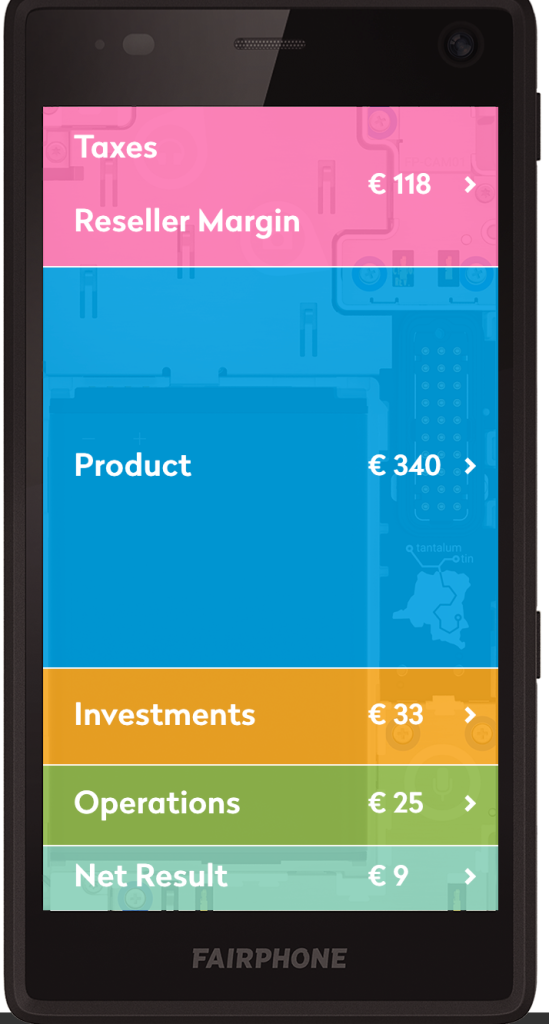
I’ve also used transparent pricing with good results.
For example, last year when we released the first version of Evolved Enterprise, I wanted to get 10,000 copies out into the world. The typical marketing angle would have been to do a “FREE + shipping” offer like others have done – but that didn’t sit right with me. Instead, we showed exactly, line by line our hard costs for the book from printing, shipping, packaging, credit card processing, etc.
Get Your Copy Of Evolved Enterprise Today (example)
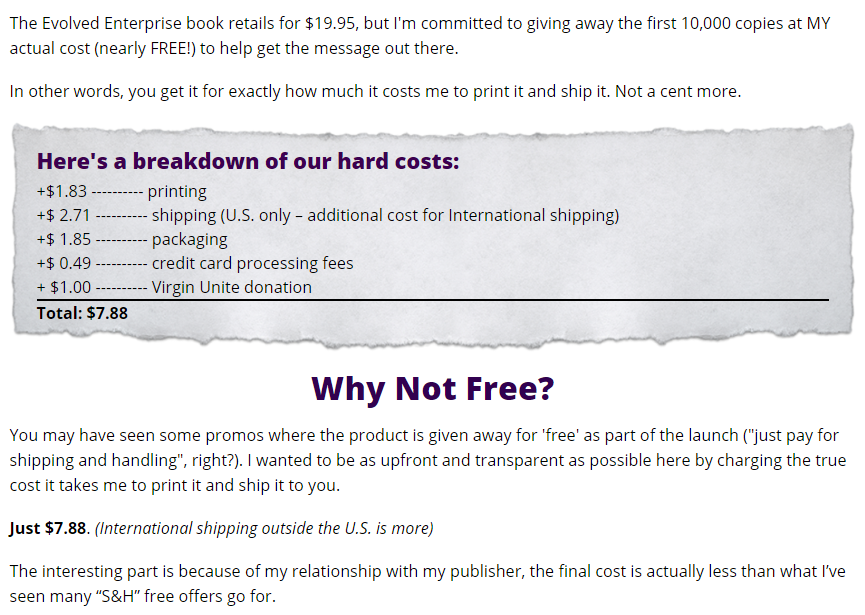
This way I was able get the price as low as possible and provide an added layer of trust for the release. We ended up selling over 12,000 books in a short time and getting it into the hands of so many impactful entrepreneurs. (Note: There is a new revised hardcover edition of Evolved Enterprise with a greater impact. Our goal is to fund 50 complementary micro-enterprises to lift an entire village in East Africa out of poverty. Get all the details on these limited edition packages here.)
Going the Opposite Way of Competitors
Southwest Airlines has bucked the trend of other airlines to find additional revenue in upsells and hidden fees. They’ve created their own word, “TransFarency” to describe the clear way they stand against baggage fees and flight change fees and even how they deal with reward points travel. No wonder, they’ve built up a sizeable group of employees and customers who love them.
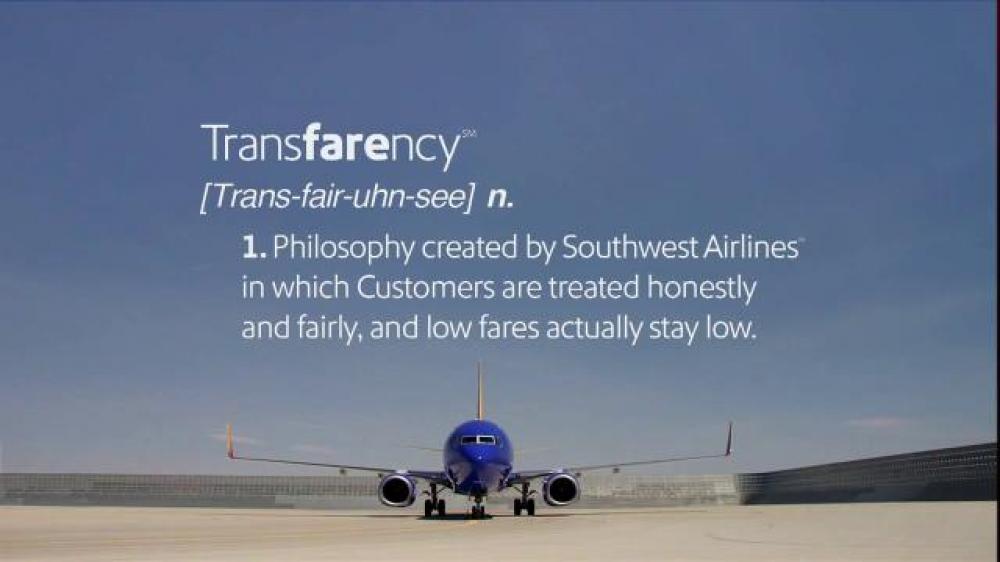
Let Your Team in On What’s Really Going On…
A few years back, I took our Maverick1000 group to Ann Arbor, MI, to meet with my friend Ari Weinzweig, co-founder of Zingerman’s. I had heard and read a bunch about Zingerman’s approach to business and knew it was interesting and different…but didn’t realize how unusual it really was until I dug in. There’s a reason Inc magazine referred to them as “the coolest business in America.”
They’ve created a grouping of 10–12 small businesses, referred to as Zingerman’s Community of Businesses, or ZCoB, that all support each other. Each one would bear the Zingerman’s name but have their own unique identity and specialty—everything from a bakeshop to a mail order facility to a training and seminar company teaching the “secret sauce” to their success.
But that’s only half the story because they sell to each other, creating a built-in customer base. For example, the bakery makes all the baked goods, breads, etc., for the deli and also sells wholesale to other retailers.
On the trip, we stopped by their Roadhouse for dinner.
It was here the group got their first taste (bad pun intended) of the Zingerman’s experience. Ari was on hand bussing tables. I nearly missed him before he “bumped” into me on purpose. After that I gave him a hard time for leaving my water glass half empty. It was interesting because it wasn’t a special thing he did because we were there. Most nights Ari is working the floor because he truly loves it and gets more insight than being in the front of the house.
But one of my biggest lessons came that night from our waitress, Alison.
I was asking her about Zingerman’s and the job, and pretty quickly our conversation turned to food costs and how she knew the doughnut dessert had a 22% food cost while the brownie sundae was 28% (or something like that). And since they are both great desserts, she would recommend the doughnut one since it would help her with the gain share all the staff are entitled to when they hit their numbers. I was blown away that our “regular” waitress would be so in tune with the finances and how they worked their way back to her bonus compensation. It makes sense since every week there is a front-of-house and back-of-house meeting where the numbers are discussed in a completely open way, practicing open book finance.
Competitive Collaboration Savings
Okay, sharing with customers and even employees is one thing, but what about sharing your best information with “competitors”? Now that would be business blasphemy, right? Maybe not if you’re Patagonia.
Yvon Choinard, the founder of Patagonia, has always been about putting the environment first—even before their company. (I actually think this has only helped their sales and fan base since consumers can spot inauthentic values.)
Over the past 40 years, Patagonia has consistently done the unusual, from looking at how to only use ethical raw material to even telling consumers to purchase less of their products with a recent Black Friday full-page ad.
As a private company with sales over $400M, Choinard is passionate about showing small and big companies how to do business in a different way. And one of those ways is helping form a Sustainable Apparel Coalition with some unlikely partners, like Walmart and Levi’s. They wanted to share best-practices to save money through environmental initiatives, like reducing its packaging and water consumption. And that’s the secret. There has to be (and there already is) a real economic incentive to make a difference.
This positive change works for everyone because it’s part of a bigger mission to make a greater difference in the world.
What do you think? Drop a comment or post another example of transparency in action.


